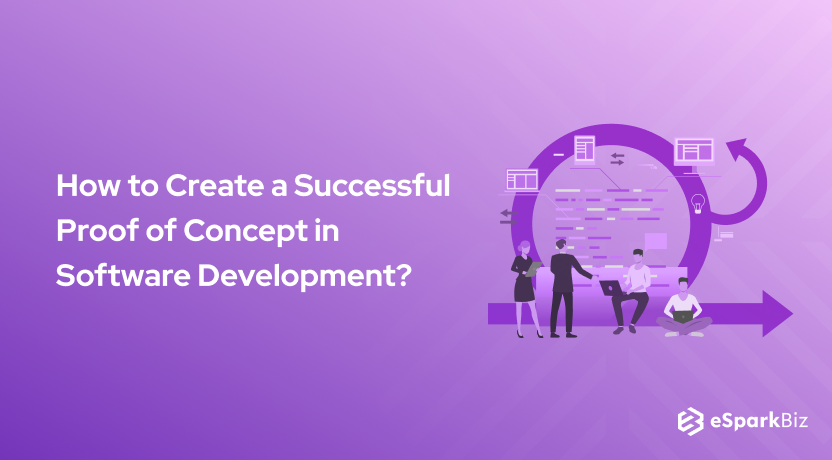Yes, you heard it right. The main goal of a Proof of Concept is to identify any technical and practical challenges in software development. Evaluating the POC’s performance and determining what helps meet the desired outcomes is crucial for businesses. It accurately reflects the vision of the final product and paves the way for its successful implementation.
Here, let us now talk in more detail and help you understand how to create a proof of concept in software development.
Understanding Proof of Concept in Software Development

POC in software development refers to creating a preliminary version or prototype of a software solution to test its feasibility and demonstrate its potential. A PoC helps stakeholders evaluate the practicality and effectiveness of the proposed software solution, identify any challenges or limitations, and make informed decisions about proceeding with the project.
It serves as a crucial step in minimizing risks and ensuring that the final product meets the desired objectives and requirements.
Proof of Concept is useful for:
- Conducting test for new business model or strategies
- Validating software ideas with the current trends
- Understanding the demand within the target market
- Determining the interest in a new or original idea
- Getting the right feedback from intended users for improvement
7 Key Steps to Create a Successful Proof of Concept

Step 1 Define your Goals
Establish the objectives and outcomes you aim to achieve with the proof of concept. This helps provide a clear focus and direction for the development process. The goals should provide a clear direction and measurable outcomes.
They could include validating the feasibility of a proposed software solution, assessing technical viability, evaluating the user experience, and identifying and gathering feedback. Defining clear and achievable goals helps guide the PoC process, measure success, and inform the next steps in the software development journey.
You need to cover and get the answers for below questions:
- What are we objectives to achieve? How it will be value-adding?
- Which criteria we need to fulfill for successful software product development?
- What would be the time duration?
- What resources will be required to achieve the goal?
Step 2 Identify Problem & Thorough Research
It is crucial to identify the problem or challenges that the proposed solution aims to address. This involves conducting thorough research to gain a deep understanding of the problem domain, the target audience, and existing solutions.
The research phase helps in uncovering insights, identifying gaps or opportunities, and refining the concept. It involves analyzing market trends, user needs, and competitor analysis.
Check out the following cases to strengthen the research:
- Look out for similar work done or previous research
- Analyze existing Expert guides, PDFs, articles & tutorials
- Prepare your plan considering the cost, competitors, timeframe, tech difficulties, etc
- Create an outline of the product functioning
Step 3 Choose the Right Technologies
It involves selecting the appropriate programming languages, frameworks, libraries, and tools that align with the project requirements and objectives. It should consider scalability, performance, compatibility, and the ability to support the POC.
Conducting research, staying updated with industry trends, and consulting with technical experts can help in making informed decisions.
There are some common questions that arises while finalizing your decision on the right technology to use:
- Who will be using the PoC?
- Will they be able to physically interact with the PoC or not?
- What is your budget to achieve the desired PoC?
- Will it be an advanced PoC or the Simple One?
Also Read: Evolving Software Development Trends In Detail
Step 4 Create your Development Team
Assembling a team with the necessary expertise and experience ensures that the POC is executed effectively. The team should consist of professionals with diverse skill sets, including software developers, designers, testers, and domain experts.
Effective communication and collaboration among team members are crucial for a smooth POC development process. Each team member should understand their roles and responsibilities, share a common vision, and work together towards achieving the defined goals.
Consider the following factors to leverage your effective Team :
- Have a smaller Development to get the work done more efficiently.
- Avoid the unnecessary UI/UX design work to effectively fulfill the goals in budget.

Step 5 Build a Prototype
A prototype serves as a tangible representation of the proposed software solution and demonstrates its core functionalities and key features. The development team focuses on creating a minimum viable product that captures the essence of the concept.
The prototype should be functional enough to showcase the intended user experience and provide a tangible demonstration of the solution’s potential.
Consider the following factors to achieve the desired POC:
- Focus on the established goals to build the desired POC, so that you don’t distracted and be on track to fulfill the required needs from the project
- Build your Prototype based on the project type and allocated resources
- Have a basic idea or structure ready in your mind so that you can easily inspect your ideas and implement them into reality to prevent excessive time and resources consumption.
Also Read: Best Minimum Viable Product Example For Startup
Step 6 Analyze the Prototype
It involves a thorough evaluation and examination of the built prototype to assess its functionality, performance, and user experience. The analysis aims to identify any technical or design issues, usability concerns, or gaps in meeting the predefined goals.
It involves soliciting feedback from stakeholders to gather their insights and perspectives. By analyzing the prototype, developers can gain valuable insights into the strengths and weaknesses of the POC, enabling them to make informed decisions and necessary adjustments for the subsequent stages of development.
Follow the below steps to get the appropriate results:
- Test your prototype in a controlled environment : You can do this by implementing Alpha Testing and Beta Testing.
- Release Prototype for Candidate Testing : Release the prototype to a small group of users and record their feedback.
Step 7 Evaluate the Results
It involves assessing the outcomes and performance of the POC against the predefined goals and success criteria. The evaluation process includes analyzing the collected data, feedback, and metrics to determine the effectiveness and viability of the concept.
By evaluating the results, stakeholders can make informed decisions about the next steps in the development process. It helps identify any limitations, technical challenges, or areas for improvement.
Vital Reasons to Create PoC in Software Development

Let’s take a look at all the vital reasons businesses will get with a PoC in software development
1. Feasibility Assessment
It helps determine whether the proposed solution can be technically implemented and if it aligns with the project goals and requirements.
2. Risk Mitigation
Developing a PoC helps identify and mitigate potential risks early in the development process. It allows you to uncover technical challenges, usability issues, or any unforeseen obstacles that may arise.
3. Stakeholder Alignment
It serves as a visual representation and allows stakeholders to gain a better understanding of the concept. It helps align the expectations and vision of different stakeholders, including clients, investors, and development teams.
4. User Feedback and Validation
Developing a PoC provides an opportunity to gather feedback from potential end-users. By involving users in the early stages, you can validate the concept, assess user acceptance, and gather insights for improvement.
5. Cost and Time Efficiency
Creating a PoC helps optimize resource allocation and reduce costs. It allows you to validate and refine your concept early on, avoiding the unnecessary development of features that may not be effective or relevant.
By investing time in the PoC stage, you can make informed decisions, prioritize features, and streamline the development process, ultimately saving time and money.
6. Decision-making and Investment
A POC provides data and evidence to support decision-making. It demonstrates the potential value of the software solution. It makes it easier to convince stakeholders and investors to commit resources for full-scale development.
By investing effort into creating a successful proof of concept, you set the foundation for a more efficient and successful software development journey.
Implementing Proof of Concept – Crucial Facts & Myths
A good understanding of the crucial facts and myths will keep business makers informed.
Let’s explore some crucial facts and myths.
Clarity of Concept
Myth
The concept will be crystal clear from the start, with a well-defined scope and objectives.
Facts
The concept may evolve and become clearer as the PoC progresses. Initial assumptions may require adjustments based on feedback and insights.
Smooth Execution
Myth
The PoC will progress smoothly without any major challenges or roadblocks.
Facts
The PoC may encounter technical, logistical, or resource-related challenges. Unforeseen issues may arise, requiring flexibility and problem-solving skills to overcome them.
Immediate Results
Myth
The PoC will yield immediate positive results, validating the concept fully.
Facts
Results may vary, and the PoC may not always achieve all desired outcomes immediately. It is an iterative process that involves learning, refining, and iterating based on feedback and evaluation.
Complete Solution
Myth
The PoC will result in a fully functional and market-ready solution.
Facts
The PoC aims to provide evidence that the concept can be realized tangibly and functionally.
Stakeholder Alignment
Myth
All stakeholders will be immediately aligned and fully supportive of the PoC.
Facts
Stakeholder alignment may take time and require ongoing communication and collaboration. Stakeholders have differing opinions and expectations that need to be addressed and resolved.
Understanding the facts behind these myths will help set realistic goals and enable effective decision-making throughout the PoC implementation. It allows for adaptability, iterative improvements, and a clearer understanding of the project’s path forward.
Conclusion
A proof of concept (PoC) is a vital step in software development that brings several benefits and considerations. It allows for the assessment of feasibility, risk mitigation, and stakeholder alignment. It is important to approach a PoC with a clear understanding of its purpose and iterative nature.
By managing expectations and leveraging the insights gained from a well-executed PoC, developers can make informed decisions, refine their concepts, and pave the way for a successful software development journey.
Why is eSparkBiz the Right Software Development partner?
eSparkBiz is an ideal software development company with a proven track record of delivering high-quality software solutions across various industries. Their extensive experience and expertise ensure that they can handle complex projects and deliver innovative and reliable solutions.
eSparkBiz has a dedicated team of skilled professionals who are proficient in the latest technologies and development methodologies.
-
How do you evaluate a proof of concept?
Evaluation of a proof of concept involves assessing its functionality, performance, user feedback, and alignment with predefined goals and success criteria.
-
What is the duration of creating a proof of concept?
The duration of creating a proof of concept varies depending on the complexity of the project. It typically ranges from a few weeks to a few months.
-
What is the difference between POV and POC?
A proof of value (POV) focuses on demonstrating the business value of a concept. A proof of concept (POC) focuses on validating the technical feasibility and functionality of a concept.







